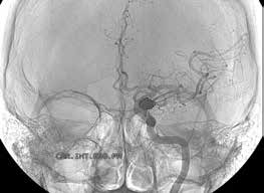
A brain aneurysm, also known as a cerebral or intracranial aneurysm, can be a frightening diagnosis for a patient and his or her family. It means that a wall in a brain artery has a bulging weak spot. As blood flows past, thinning of this spot can increase, and a break—like an overfilled balloon popping—can occur. Ideally, the aneurysm is identified and treated before a life-threatening rupture happens.
When deciding on treatment for a newly diagnosed aneurysm, physicians take into account several factors, including
- the patient’s age
- his or her overall physical condition
- family history of aneurysm
- the specifics of the aneurysm
One popular treatment option is endovascular embolization, also known as coiling. Coiling, in fact, can also be used to repair an aneurysm that has already ruptured.
Endovascular embolization is complicated surgery, involving tiny incisions, catheters and microcatheters, contrast dye, angiograms and constant x-ray visualization during the procedure. Ultimately, with the help of an electric current, the surgeon places platinum coils directly into the aneurysm. The coils block blood flow to that tiny area so blood no longer puts pressure on the artery wall that can possibly cause a rupture.
After coiling, the recovery process, including gradual return to physical activity, begins as soon as it’s deemed safe. Physical therapy in the hospital generally starts with comfortable movement in a lying-down or sitting position, transitioning to sitting on the edge of the bed, standing and walking. Subsequently, the areas of focus include balance, posture, range of motion and activities of daily living.
Physical therapy continues after the patient is released from the hospital. Together with your physicians, we can design a customized program that allows further recovery, with exercises at home and/or at our facility. If the treatment was for an unruptured aneurysm, full activity can usually be resumed within a few weeks after surgery.
